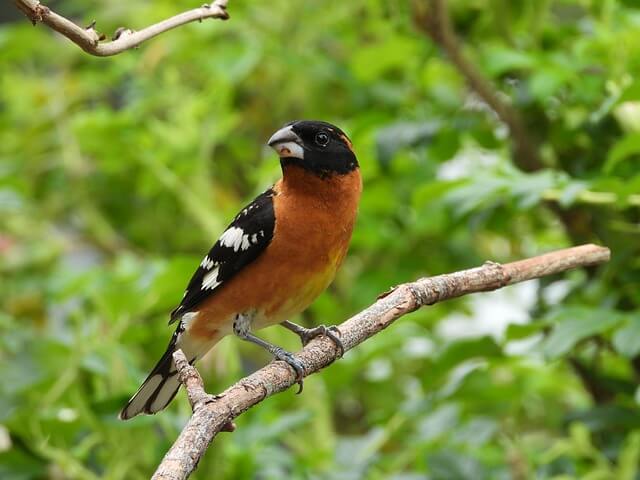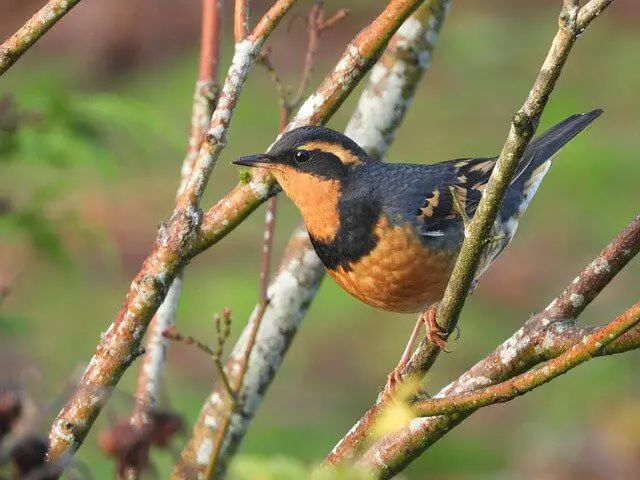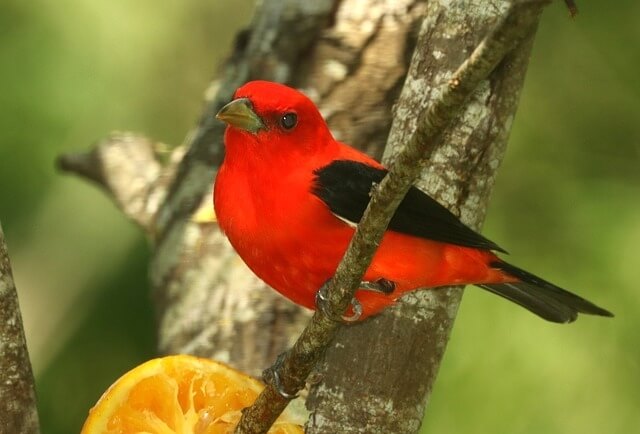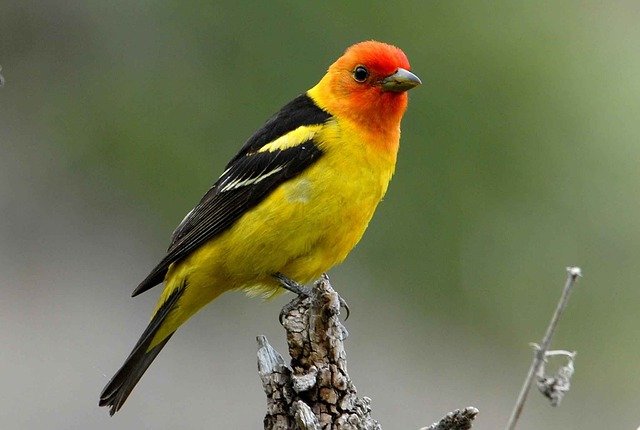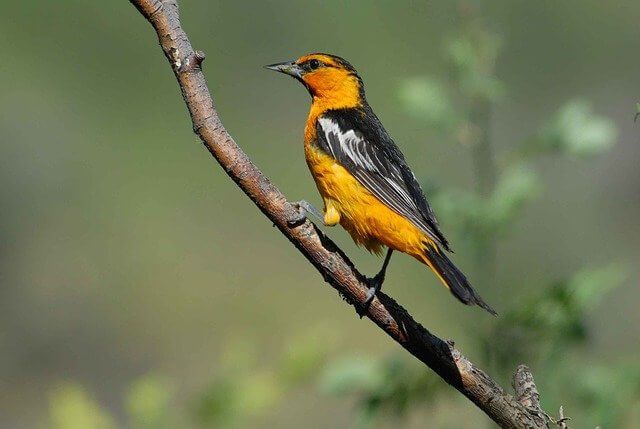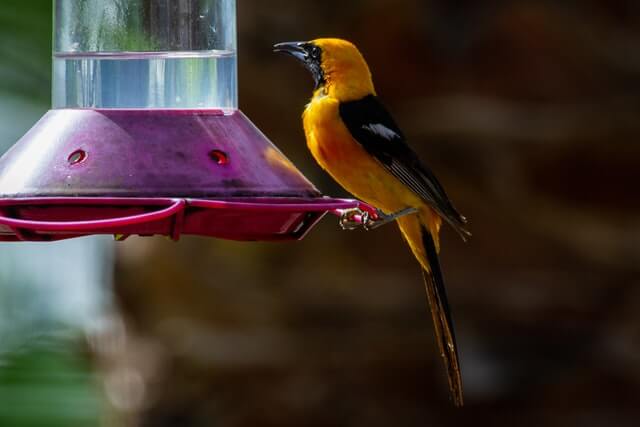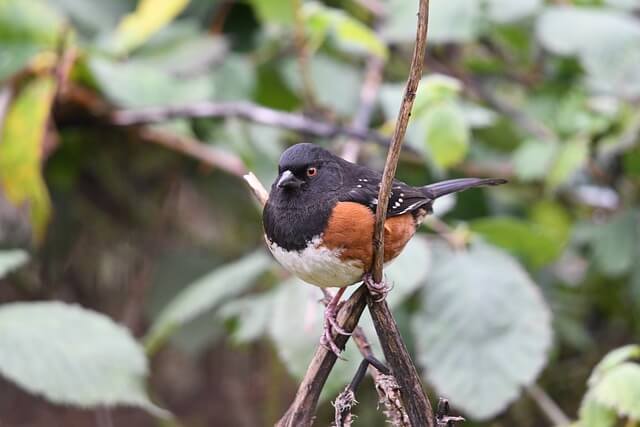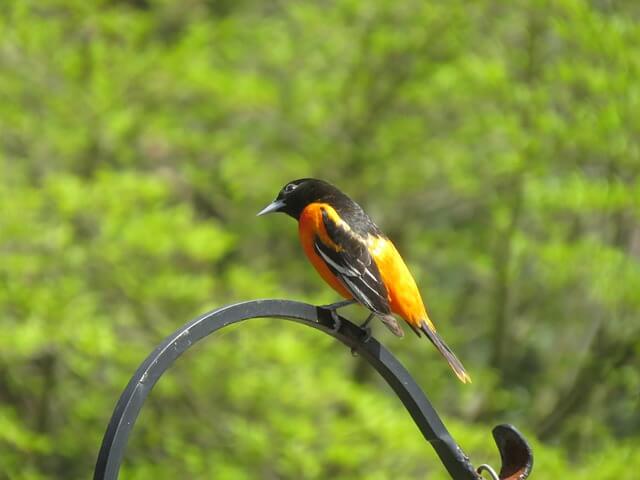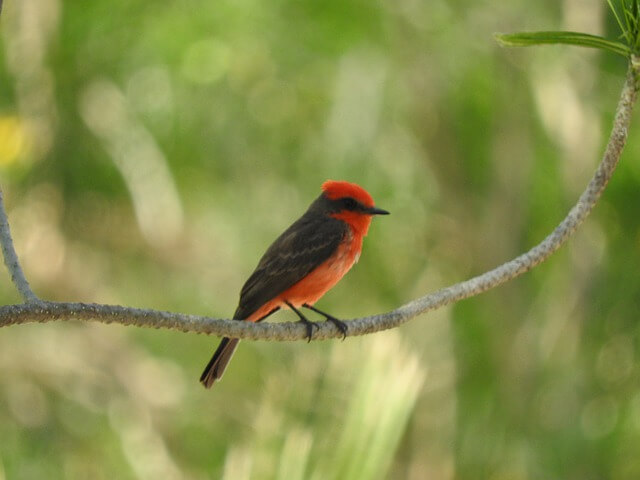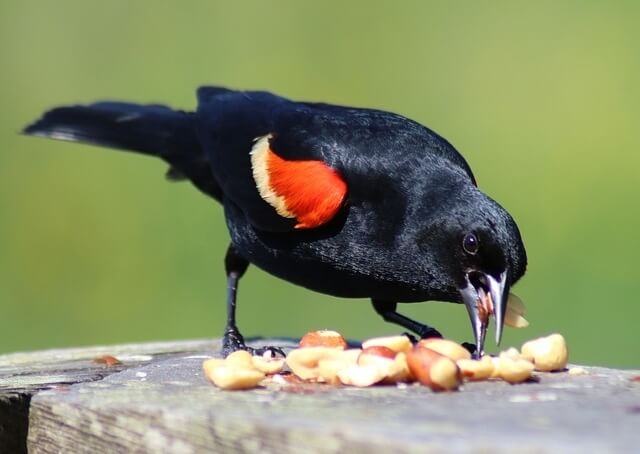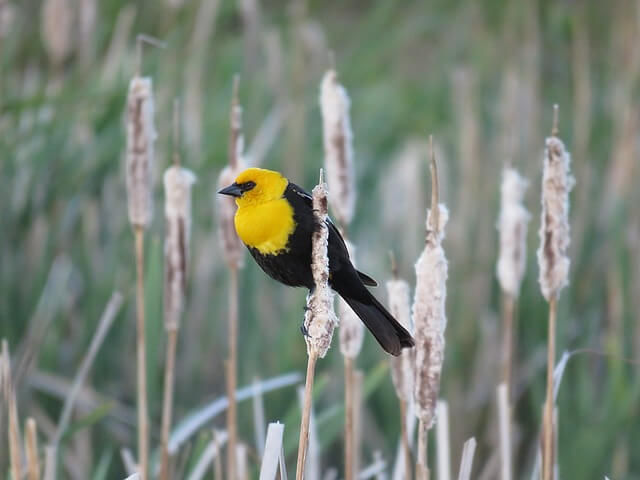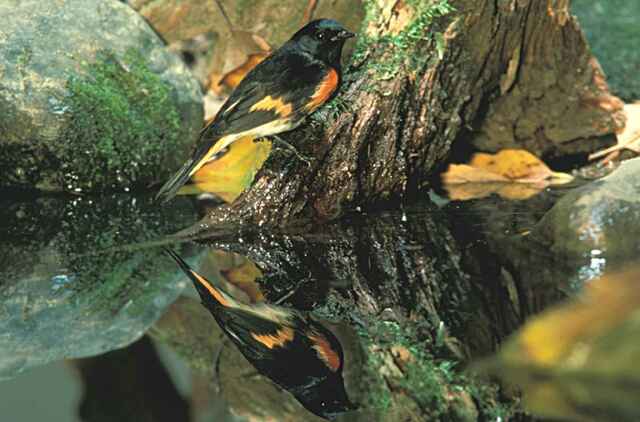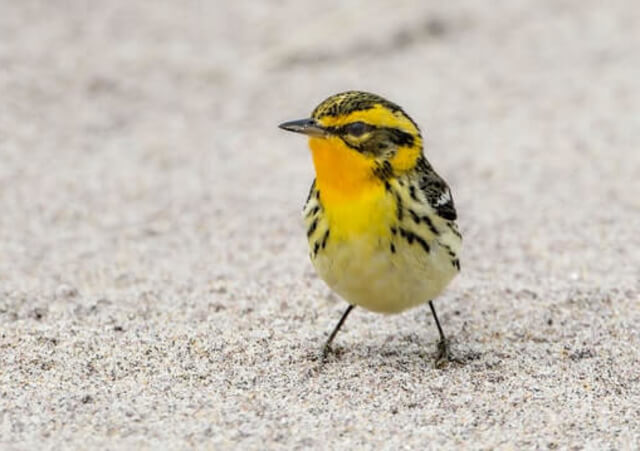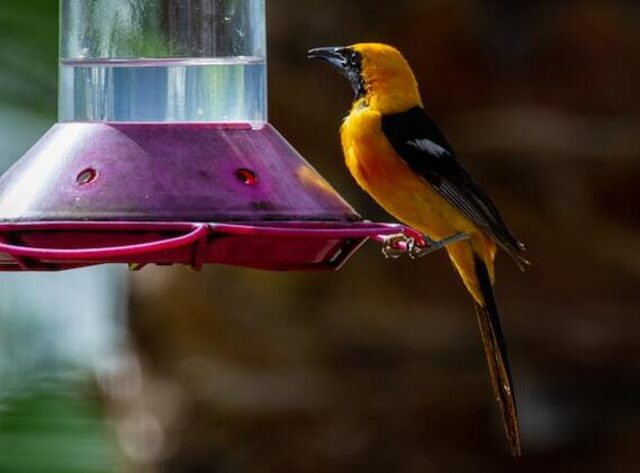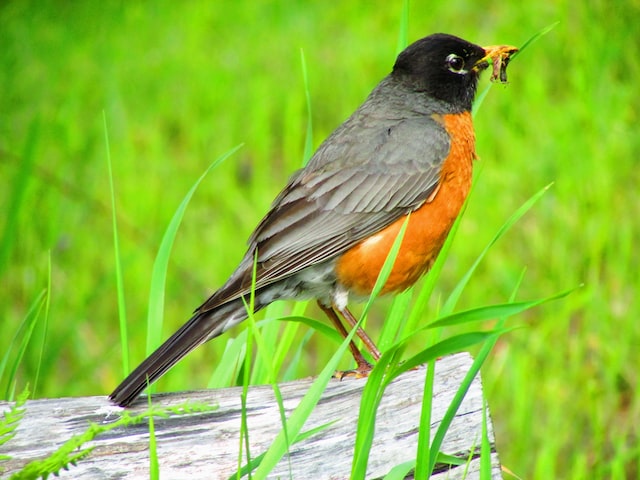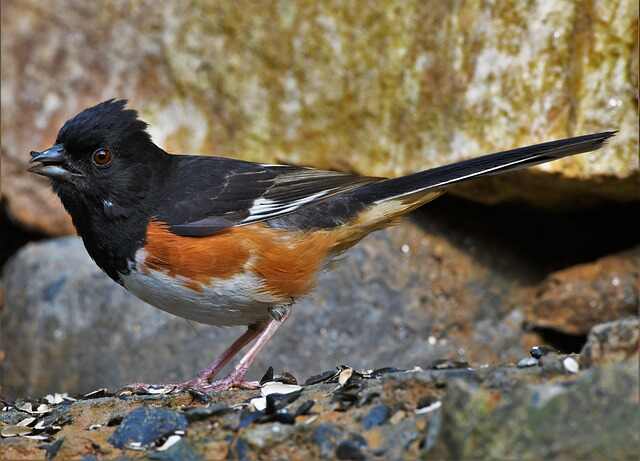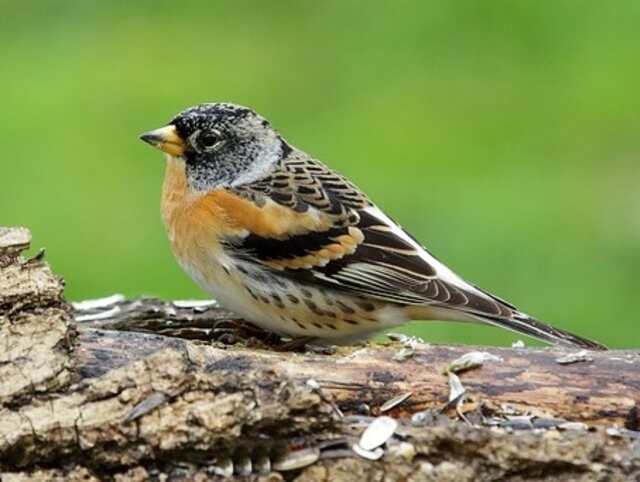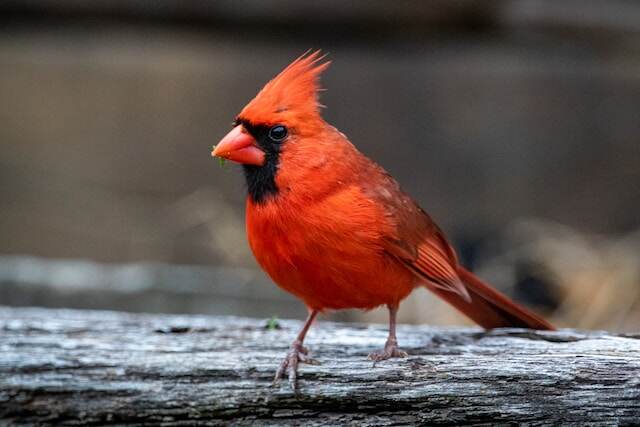Birds that are orange and black are some of the most striking creatures in the birdwatching world. From the vibrant Baltimore Oriole to the elegant Black-and-Orange Warbler, these colorful birds are a joy to observe. In this guide, we’ll introduce you to 21 amazing birds that showcase a stunning blend of orange and black, highlighting their unique features and the best places to spot them in the wild.
Click the Play button below to listen to our podcast:
Table of Contents
- 1 Birds That Are Orange And Black
- 1.1 Black-headed Grosbeak
- 1.2 Varied Thrush
- 1.3 Scarlet Tanager
- 1.4 Western Tanager
- 1.5 Bullock’s Oriole
- 1.6 Streak-backed Oriole
- 1.7 Orchard Oriole
- 1.8 Spotted Towhee
- 1.9 Baltimore Oriole
- 1.10 Vermilion Flycatcher
- 1.11 Red-winged Blackbird
- 1.12 Yellow-headed Blackbird
- 1.13 American Redstart
- 1.14 Blackburnian Warbler
- 1.15 Spot-breasted Oriole
- 1.16 Hooded Oriole
- 1.17 Altamira Oriole
- 1.18 American Robin
- 1.19 Eastern Towhee
- 1.20 Brambling
- 1.21 Northern Cardinal
- 2 Frequently Asked Questions
- 2.1 What is an orange and black bird?
- 2.2 What is an orange bird with a black head?
- 2.3 Are there any orange and black birds?
- 2.4 Can you identify a black and orange bird?
- 2.5 What bird has a black head and orange body?
- 2.6 What birds have orange and black feathers?
- 2.7 Do any birds have orange and black feathers?
- 2.8 Which birds are black with orange?
- 2.9 Are there orange, yellow, and black birds?
- 2.10 Is there an orange-breasted bird with a black head?
- 2.11 Are there any small black and orange birds?
- 2.12 Which birds are black, white, and orange?
- 2.13 What bird is orange and black?
- 2.14 Are there any bright orange and black birds?
- 2.15 What small birds are orange and black?
- 2.16 Which birds have an orange head and black body?
- 2.17 Do birds exist that are orange, black, and white?
- 2.18 Which birds have a black head and orange chest?
- 2.19 Are there birds with an orange body and black head?
- 2.20 Which birds are black with an orange breast?
- 2.21 Do birds have an orange chest and are black?
- 2.22 Can you identify small orange and black birds?
- 2.23 What are black and orange warblers?
- 2.24 Which birds have an orange belly and black head?
- 3 Author
Birds That Are Orange And Black
Black-headed Grosbeak
Black-headed Grosbeaks are medium-sized birds commonly found in the Western United States, Canada, and the southern states of Mexico. They are easily identifiable by their striking appearance, featuring black heads, backs, and wings, complemented by white patches and vibrant orange underparts.
These versatile birds contribute to natural pest control by feasting on insects and relishing a variety of berries, including elderberries and blueberries. When it’s time for nesting, they seek out natural cavities or accept nest boxes, preferably near water sources like streams and rivers in woodlands and forests.
These grosbeaks are a familiar sight in gardens and at feeders, where they have a penchant for fruits, seeds, and berries. While they typically mate for life, the occasional change in partners can occur if one passes away.
| Fact | Information |
|---|---|
| Scientific Name | Pheucticus melanocephalus |
| Range | Western North America |
| Habitat | Woodlands, forests, shrubby areas |
| Size | 7-8 inches (18-20 cm) |
| Diet | Insects, berries, seeds |
| Plumage | Males: Black heads, orange underparts; Females: Brown heads, streaked underparts |
| Song | Rich, melodious whistling song |
| Migration | They migrate to Central and South America for the winter |
| Conservation Status | Not globally threatened; populations stable |
| Attracting Tips | Provide berry-bearing plants, bird feeders with seeds and fruits, and a water source in your garden to attract Black-headed Grosbeaks. |
Varied Thrush
The Varied Thrush, known for its striking appearance, inhabits North America, displaying an orange breast and distinctive black head and back. Its range spans from Alaska to the southern United States, and during winter, they migrate through Canada and Mexico.
Typically found in forests and shrubby areas, Varied Thrushes have a varied diet, consuming invertebrates like spiders, snails, caterpillars, beetles, crickets, and berries, adjusting their food choices to local availability.
Breeding from May to July, they build nests near or on the ground, often concealed under leaf litter, rocks, or dense vegetation, providing thermal protection for their eggs and chicks. The Varied Thrush’s intriguing appearance, migratory patterns, and ecological significance make it a cherished sight for bird enthusiasts.
| Fact | Information |
|---|---|
| Scientific Name | Ixoreus naevius |
| Range | Western North America, from Alaska to California |
| Habitat | Coniferous and mixed forests |
| Size | 7-8 inches (18-20 cm) |
| Diet | Insects, spiders, fruits, berries |
| Plumage | Slate-blue upperparts, vibrant orange patch on underparts |
| Song | Rich, flute-like whistling song |
| Migration | They migrate south for the winter |
| Conservation Status | Not globally threatened; populations stable |
| Attracting Tips | Plant berry-producing shrubs and provide a water source in your garden to attract Varied Thrushes. |
Scarlet Tanager
The Scarlet Tanager (Piranga olivacea) is a brilliantly colored bird found in the woodlands of eastern North America. Male Scarlet Tanagers are striking with their vivid red plumage and black wings, while females have a more subdued appearance. These birds prefer deciduous and mixed forests for nesting and feeding and are common in the summer months.
Measuring 6.3 to 7.5 inches (16-19 cm) in length, their diet includes insects, spiders, and fruits like mulberries and cherries. They’re known for their melodious, robin-like warble, making them a favorite among bird enthusiasts.
Scarlet Tanagers migrate to northern South America during the winter, but their populations remain stable. This stability ensures birdwatchers can continue to enjoy their stunning plumage and enchanting songs in the woodlands of eastern North America.
| Fact | Information |
|---|---|
| Scientific Name | Piranga olivacea |
| Range | Eastern North America, from southern Canada to the northern parts of South America |
| Habitat | Deciduous forests, often seen in treetops |
| Size | 6.3-7.5 inches (16-19 cm) |
| Diet | Insects, primarily bees, wasps, and other arthropods; also fruits and berries |
| Plumage | Males: Bright scarlet with black wings and tail; Females: Greenish-yellow with dark wings |
| Song | Repeated, high-pitched, and raspy phrases |
| Migration | They migrate to Central and South America for the winter |
| Conservation Status | Not globally threatened; populations stable |
| Attracting Tips | Maintain a habitat with a variety of insects and flowering trees and shrubs to attract Scarlet Tanagers. |
Western Tanager
The Western Tanager is a stunning bird native to the western regions of North America. It is known for its striking appearance, featuring a vibrant red head, bright yellow body, and contrasting black wings. These birds are commonly spotted in coniferous and mixed forests, often perched in treetops.
Western Tanagers primarily feed on insects, including bees, wasps, and other arthropods, but they also enjoy fruits and berries. Their melodic and musical songs resonate through the trees during the breeding season. In winter, they migrate to Central America.
To attract Western Tanagers, consider providing a mix of insects, fruit-bearing plants, and tall trees for nesting in your garden. Bird enthusiasts cherish their presence for their unique plumage and delightful songs.
| Fact | Information |
|---|---|
| Scientific Name | Piranga ludoviciana |
| Range | Western North America, from Alaska to Central America |
| Habitat | Coniferous and mixed forests, often seen in treetops |
| Size | 6.3-7.1 inches (16-18 cm) |
| Diet | Primarily insects, including bees, wasps, and other arthropods; also fruits and berries |
| Plumage | Males: Bright red head, yellow body with black wings; Females: Yellowish-green |
| Song | Musical and melodious, described as a series of short phrases |
| Migration | They migrate to Central America for the winter |
| Conservation Status | Not globally threatened; populations stable |
| Attracting Tips | Provide a mix of insects, fruit-bearing plants, and tall trees for nesting to attract Western Tanagers. |
Bullock’s Oriole
Bullock’s Oriole is a captivating bird species found in western North America. These orioles exhibit striking sexual dimorphism with males boasting bright orange plumage, while females display a more subtle yellow hue. They inhabit various forested environments, often near open woodlands and riparian zones.
Their diet primarily consists of insects, spiders, and nectar, making them a versatile forager. Bullock’s Orioles are known for their hanging, pouch-like nests, woven meticulously in tall trees, often cottonwoods or oaks. During the summer, they breed across the western United States and parts of Canada.
To attract these vibrant birds, consider setting up bird feeders with nectar and offering a diverse range of insects, as well as providing suitable trees for nesting. Bullock’s Orioles are a delight for bird enthusiasts, admired for their distinctive plumage and melodic calls.
| Fact | Information |
|---|---|
| Scientific Name | Icterus bullockii |
| Range | Western North America, from southern Canada to northern Mexico |
| Habitat | Open woodlands, streamside groves, and suburban areas |
| Size | 7-8 inches (18-20 cm) |
| Diet | Primarily insects, including caterpillars, ants, and spiders; also nectar, fruit, and berries |
| Plumage | Bright orange with a black throat and black eye line |
| Song | Melodic whistles and warbles |
| Migration | They migrate to Central America for the winter |
| Conservation Status | Not globally threatened; populations stable |
| Attracting Tips | Offer sugar water or nectar feeders and plant nectar-rich flowers to attract Bullock’s Orioles. |
Streak-backed Oriole
The Streak-backed Oriole, a captivating bird, inhabits parts of the southwestern United States and Mexico. Its distinct appearance includes a striking combination of orange plumage, black streaks, and white underparts. These orioles prefer arid landscapes such as deserts, thornscrub, and urban areas.
Their diet mainly consists of insects, nectar, and fruit, making them adaptable foragers. Streak-backed Orioles are known for their chattering and melodious songs, enhancing the ambiance of their habitat. During the breeding season, they construct pendulous nests in thorny trees.
To attract Streak-backed Orioles to your area, consider planting nectar-producing flowers and providing fruit feeders. These vibrant birds are a prized sight for birdwatchers, appreciated for both their striking appearance and enchanting songs.
| Fact | Information |
|---|---|
| Scientific Name | Icterus pustulatus |
| Range | Southwestern United States and western Mexico |
| Habitat | Desert and arid shrublands |
| Size | 7.5-8.3 inches (19-21 cm) |
| Diet | Insects, spiders, and nectar |
| Plumage | Bright orange with a streaked back |
| Song | Musical whistles and chattering calls |
| Migration | They are non-migratory, residing in their range year-round |
| Conservation Status | Not globally threatened; populations stable |
| Attracting Tips | Plant desert-friendly flowering plants and provide a water source to attract Streak-backed Orioles. |
Orchard Oriole
The Orchard Oriole, a small and vibrant bird, is a delightful sight in North America during the summer months. Males boast striking orange plumage, while females are a more subdued yellow-green. They can be found in orchards, gardens, and open woodlands.
Orchard Orioles primarily feed on insects, such as caterpillars and beetles, but they also enjoy nectar and fruit. During breeding season, they build their cup-shaped nests in trees. Although they are not known for extensive migrations, they do travel to Central America for the winter.
To attract Orchard Orioles, consider planting fruit-bearing trees, providing nectar feeders, and maintaining a variety of insects in your garden. Bird enthusiasts admire these orioles for their colorful appearance and charming presence.
| Fact | Information |
|---|---|
| Scientific Name | Icterus spurius |
| Range | Eastern North America, from the United States to Central America |
| Habitat | Woodlands, orchards, and open areas with deciduous trees |
| Size | 6.3-7.1 inches (16-18 cm) |
| Diet | Insects, spiders, and nectar |
| Plumage | Adult males: Bright orange with black wings; Females: Greenish-yellow |
| Song | A series of whistles and chatter-like calls |
| Migration | They migrate to Central America for the winter |
| Conservation Status | Not globally threatened; populations stable |
| Attracting Tips | Plant flowering trees, shrubs, and provide nectar feeders to attract Orchard Orioles. |
Spotted Towhee
The Spotted Towhee is a distinctive bird species found in North America. These birds are known for their striking black plumage with white spots, complemented by their bright red eyes. They are typically found in various habitats, including open woodlands, brushy areas, and backyards.
Spotted Towhees have a diverse diet that includes seeds, insects, and berries. They are ground foragers and often scratch at the leaf litter in search of food. During the breeding season, they build their nests on or near the ground in dense shrubs or thickets.
Their songs are characterized by repetitive, scratchy calls that sound like “drink your tea.” Attracting Spotted Towhees to your yard can be done by offering a variety of seeds, suet, and providing shelter in the form of dense shrubs. Birdwatchers enjoy observing these striking birds in their natural habitat.
| Fact | Information |
|---|---|
| Scientific Name | Pipilo maculatus |
| Range | Western and southwestern North America |
| Habitat | Brushy areas, forests, chaparral, and urban parks |
| Size | 6.7-9.1 inches (17-23 cm) |
| Diet | Insects, seeds, fruits, and berries |
| Plumage | Black head, white spots on wings, and rufous sides |
| Song | Repeated metallic “mew” calls and trills |
| Migration | Most populations are non-migratory, residing year-round |
| Conservation Status | Not globally threatened; populations stable |
| Attracting Tips | Offer a variety of seeds, suet, and low ground feeders to attract Spotted Towhees. |
Baltimore Oriole
The Baltimore Oriole, a vibrant songbird, is native to North America and well-known for its striking orange and black plumage. Males exhibit bright orange plumage with black wings, while females are more subdued with olive-yellow tones. These orioles are commonly found in open woodlands, orchards, and suburban areas, often building their distinctive hanging nests in deciduous trees.
Their diet primarily consists of insects, nectar, and fruit, with a particular affinity for oranges and other citrus fruits. Baltimore Orioles are known for their enchanting songs, and their sweet, melodious calls are a delight to bird enthusiasts.
They are migratory birds, spending the winter in Central and South America. To attract Baltimore Orioles to your yard, provide them with oranges, nectar feeders, and suitable nesting sites, enhancing your birdwatching experience.
| Fact | Information |
|---|---|
| Scientific Name | Icterus galbula |
| Range | Eastern North America, from the United States to Canada |
| Habitat | Deciduous woodlands, parks, and gardens |
| Size | 7-8 inches (18-20 cm) |
| Diet | Insects, fruits, and nectar |
| Plumage | Bright orange with black wings and tail feathers |
| Song | A rich, melodious, and flute-like warbling song |
| Migration | They migrate to Central America for the winter |
| Conservation Status | Not globally threatened; populations stable |
| Attracting Tips | Provide fruit feeders, sugar water, and flowering trees to attract Baltimore Orioles. |
Vermilion Flycatcher
The Vermilion Flycatcher is a striking bird native to the southwestern regions of North America. Known for its vibrant and eye-catching appearance, the male Vermilion Flycatcher features brilliant red plumage with a contrasting dark crown and wings.
These birds are often found in open habitats such as deserts, grasslands, and riparian areas, where they feed primarily on insects, including flies, mosquitoes, and other small prey. Their energetic aerial foraging and distinctive fluttering flight patterns make them a captivating sight for bird enthusiasts. During the breeding season, males perform aerial displays to attract females.
Vermilion Flycatchers tend to remain in their territories year-round in milder climates but may migrate short distances in response to food availability. To attract Vermilion Flycatchers, consider maintaining open landscapes and providing suitable nesting sites. Birdwatchers admire them for their vibrant plumage and acrobatic hunting techniques.
| Fact | Information |
|---|---|
| Scientific Name | Pyrocephalus rubinus |
| Range | Southwestern United States, Central America, and South America |
| Habitat | Open areas, grasslands, deserts, and riparian habitats |
| Size | 6-6.7 inches (15-17 cm) |
| Diet | Primarily insects, including flies, beetles, and grasshoppers; occasionally berries |
| Plumage | Vivid red plumage for males, duller with some red for females |
| Song | Melodic, high-pitched whistles and calls |
| Migration | Some northern populations migrate south for the winter |
| Conservation Status | Not globally threatened; populations stable |
| Attracting Tips | Create open spaces with perching spots, and provide insects as a food source to attract Vermilion Flycatchers. |
Red-winged Blackbird
The Red-winged Blackbird is a common sight across North America. Males are recognizable by their glossy black plumage and distinctive reddish-orange and yellow shoulder patches, which they display during territorial and courtship behaviors. The females, in contrast, have streaked brown plumage for better camouflage while nesting.
These birds primarily inhabit wetlands, marshes, and grassy areas, where they forage for insects, seeds, and aquatic invertebrates. Red-winged Blackbirds are often heard before they’re seen, with a distinctive call that sounds like “oak-a-lee.”
They are social birds, often seen in large flocks during migration. To attract Red-winged Blackbirds to your yard, provide water sources, cattails, and shrubs for nesting. Birdwatchers appreciate their vibrant appearance and lively behaviors.
| Fact | Information |
|---|---|
| Scientific Name | Agelaius phoeniceus |
| Range | North America, from Alaska to Central America |
| Habitat | Wetlands, marshes, and grassy areas |
| Size | 7-9 inches (18-23 cm) |
| Diet | Primarily insects, spiders, and seeds; also aquatic invertebrates |
| Plumage | Males: Glossy black with red shoulder patches; Females: Brown streaked |
| Song | High-pitched, distinctive “conk-la-ree” call |
| Migration | Some northern populations migrate south for the winter |
| Conservation Status | Not globally threatened; populations stable |
| Attracting Tips | Maintain wetland or marshy areas with suitable nesting sites and food to attract Red-winged Blackbirds. |
Yellow-headed Blackbird
The Yellow-headed Blackbird is a striking bird found in North America, primarily in the western regions. Recognizable by its bright yellow head, black body, and white wing patches, these birds prefer marshes, wetlands, and open grassy areas for their habitats. Their diet is diverse, encompassing seeds, insects, and even small fish, as they forage in aquatic environments.
During the breeding season, the males exhibit impressive territorial and courtship displays. These birds tend to form nesting colonies in dense marsh vegetation. They are mostly sedentary, but some populations migrate short distances.
To attract Yellow-headed Blackbirds, consider maintaining wetlands and water sources, which are essential for their survival. Birdwatchers appreciate the opportunity to spot these unique blackbirds with their vibrant yellow heads in wetland habitats.
| Fact | Information |
|---|---|
| Scientific Name | Xanthocephalus xanthocephalus |
| Range | Western North America, from Alaska to Central Mexico |
| Habitat | Marshes, wetlands, and reed beds |
| Size | 9-10 inches (23-25 cm) |
| Diet | Insects, seeds, and some aquatic invertebrates |
| Plumage | Bright yellow head and breast; black body and wings |
| Song | Complex songs and calls, often resembling grating sounds |
| Migration | Some populations migrate to the southern United States for the winter |
| Conservation Status | Not globally threatened; populations stable |
| Attracting Tips | Preserve and restore wetland habitats and provide tall vegetation for nesting to attract Yellow-headed Blackbirds. |
American Redstart
The American Redstart, a small but vibrant bird, inhabits North America during its breeding season. It’s recognized for its striking plumage, with males boasting bold black and orange colors, while females have more subdued plumage.
They primarily inhabit deciduous woodlands, where they forage for insects like caterpillars and beetles. Redstarts are known for their unique foraging behavior, constantly flicking their wings open to startle insects from leaves. During the breeding season, their songs fill the forest with a series of high-pitched, musical notes.
These birds are migratory and spend their winters in Central and South America. To attract American Redstarts to your yard, provide a mix of insects, shrubs for nesting, and shaded areas for foraging. Birdwatchers appreciate their lively presence and striking colors.
| Fact | Information |
|---|---|
| Scientific Name | Setophaga ruticilla |
| Range | Eastern and northern North America |
| Habitat | Deciduous forests, especially near water |
| Size | 4-5 inches (10-13 cm) |
| Diet | Insects and spiders, often caught while in flight |
| Plumage | Males: Black with orange patches; Females: Gray-green with yellow patches |
| Song | A series of high-pitched musical notes |
| Migration | Neotropical migrant, spending winters in Central and South America |
| Conservation Status | Not globally threatened; populations stable |
| Attracting Tips | Maintain a mix of deciduous trees, shrubs, and a water source to attract American Redstarts. |
Blackburnian Warbler
The Blackburnian Warbler, a striking migratory songbird, graces North American woodlands with its vibrant plumage and melodious tunes. Males are particularly eye-catching, with fiery orange throats and contrasting black markings on their wings and face.
They typically breed in northern coniferous forests and migrate to Central and South America during the winter months. These warblers are insectivores, primarily feeding on spiders, insects, and other small invertebrates. They are skilled foragers, flitting through tree canopies in search of prey.
To attract Blackburnian Warblers to your area, consider planting native trees and shrubs that provide insects and create a welcoming habitat. Birdwatchers appreciate the opportunity to observe these colorful birds during their breeding season.
| Fact | Information |
|---|---|
| Scientific Name | Setophaga fusca |
| Range | Eastern North America, northern Central America |
| Habitat | Coniferous and mixed forests, especially high in trees |
| Size | 4.3-5.1 inches (11-13 cm) |
| Diet | Insects, often gleaned from tree leaves and needles |
| Plumage | Males: Bright orange throat and crown with black streaks; Females: Duller plumage |
| Song | High-pitched, rising song with a distinctive ending |
| Migration | Neotropical migrant, winters in Central and South America |
| Conservation Status | Not globally threatened; populations stable |
| Attracting Tips | Provide a variety of insects and maintain coniferous trees in your area to attract Blackburnian Warblers. |
Spot-breasted Oriole
The Spot-breasted Oriole is a songbird. It has an orange body with black wings and tail, but its most distinguishing feature is the bright yellow spots on its breast.
The oriole can be found in tropical regions of Central America, South America, and southern North America. It prefers to live in moist tropical forests but can also be seen at lower elevations.
These birds are not migratory, so they stay in their same area year round where they live in large flocks for protection against predators.
They feed on insects, nectar from flowers, fruit and sap from trees. It’s one of the more difficult to spot bird species in its habitat, and has been described as “common but elusive.
| Fact | Information |
|---|---|
| Scientific Name | Icterus pectoralis |
| Range | Western Mexico, especially in coastal areas |
| Habitat | Tropical and subtropical regions, often near human habitation |
| Size | 7.5-8.3 inches (19-21 cm) |
| Diet | Insects, spiders, nectar, fruit, and berries |
| Plumage | Bright orange-yellow with a spot on the breast |
| Song | Musical whistles and chattering calls |
| Migration | They are non-migratory, residing in their range year-round |
| Conservation Status | Not globally threatened; populations stable |
| Attracting Tips | Plant fruiting and flowering trees and offer nectar to attract Spot-breasted Orioles. |
Hooded Oriole
The Hooded Oriole (Icterus cucullatus) is a small icterid bird. It breeds in the southern United States, Mexico, and parts of Central America. The Hooded Oriole is a relatively uncommon bird, but can be found in a variety of habitats including woodlands, gardens, and parks.
The Hooded Oriole is easily distinguished from other orioles by its black hood and orange body. The male has an orange head and breast with a black back and wings. The female is similar to the male but with a greenish back and wings.
Hooded Orioles are insectivores and primarily eat caterpillars, beetles, and spiders. They will also eat berries, fruits, and nectar. In urban areas, they will often visit bird feeders.
| Fact | Information |
|---|---|
| Scientific Name | Icterus cucullatus |
| Range | Southwestern United States and Mexico |
| Habitat | Arid and semi-arid regions, including deserts, palm oases, and urban areas |
| Size | 7-7.5 inches (18-19 cm) |
| Diet | Nectar, insects, and fruit |
| Plumage | Bright orange with a black throat, back, and face; males have a black hood |
| Song | Melodic, flutelike whistles and chattering calls |
| Migration | Non-migratory, resident year-round in their range |
| Conservation Status | Not globally threatened; populations stable |
| Attracting Tips | Plant nectar-rich flowers, provide sugar water feeders, and create a water source to attract Hooded Orioles. |
Altamira Oriole
The Altamira Oriole is a brightly colored bird found in the southern United States and Mexico. The adult Altamira Oriole has an orange body with a black mask and wings. The juvenile Altamira Oriole is mostly yellow, with some grayish black on the wings and tail.
The Altamira Oriole ranges from southeastern Arizona and southwestern New Mexico south through Mexico to northwestern Costa Rica. The Altamira Oriole inhabits open woodlands, including deciduous forests, riparian woodlands, and mangroves.
The diet of the Altamira Oriole consists primarily of insects and nectar. The Altamira Oriole will also eat fruit, particularly during the winter months.
| Fact | Information |
|---|---|
| Scientific Name | Icterus gularis |
| Range | South Texas, Mexico, and Central America |
| Habitat | Wooded habitats, riparian areas, and open woodlands |
| Size | 9-10 inches (23-25 cm) |
| Diet | Primarily insects and fruit; occasionally nectar |
| Plumage | Bright orange with a black bib and face |
| Song | Rich, melodic whistles and chattering calls |
| Migration | They are non-migratory, residing in their range year-round |
| Conservation Status | Not globally threatened; populations stable |
| Attracting Tips | Create a habitat with diverse fruit-bearing plants, provide fruit feeders, and offer fresh water to attract Altamira Orioles. |
American Robin
The American Robin is a widely recognized and beloved bird throughout North America. With its distinctive orange-red breast, gray upperparts, and a white eye ring, it’s a common sight in suburban gardens and wooded areas. Robins are versatile foragers, feeding on a diverse diet of earthworms, insects, berries, and fruits.
They are known for their melodious and cheerful songs that fill the air during the spring and summer months. American Robins usually nest in trees and shrubs, and their nests are often well-hidden. They are not migratory, and many stay in their breeding areas year-round.
To attract American Robins to your garden, provide a variety of food sources such as fruit-bearing trees and shrubs, as well as bird baths and nesting platforms. Birdwatchers appreciate their friendly and familiar presence.
| Fact | Information |
|---|---|
| Scientific Name | Turdus migratorius |
| Range | North America, from Alaska and Canada to Mexico |
| Habitat | Woodlands, gardens, open fields, and urban areas |
| Size | 10-11 inches (25-28 cm) |
| Diet | Primarily earthworms, insects, fruits, and berries |
| Plumage | Gray-brown with a distinctive orange-red breast |
| Song | Cheerful, melodious carol |
| Migration | Many migrate to the southern United States for the winter |
| Conservation Status | Not globally threatened; populations stable |
| Attracting Tips | Offer a varied diet, including fruit, mealworms, and insects; provide water and a birdbath for bathing. |
Eastern Towhee
The Eastern Towhee is a charismatic bird native to eastern North America. With its striking black upperparts and contrasting rufous sides, this bird is easy to identify. These ground-dwelling birds forage for insects, seeds, and fruits in the underbrush and leaf litter.
Their breeding season typically starts in late spring and extends into summer. Eastern Towhees construct their nests on or near the ground in dense vegetation. During the winter, some migrate to milder climates, while others stay in their breeding territories year-round.
To attract Eastern Towhees to your yard, provide a variety of seeds, insects, and shrubby areas for cover. Bird enthusiasts admire their bold and distinctive markings, making them a cherished sight for many.
| Fact | Information |
|---|---|
| Scientific Name | Pipilo erythrophthalmus |
| Range | Eastern and southeastern United States |
| Habitat | Woodlands, thickets, and brushy areas |
| Size | 7-8.5 inches (18-21.5 cm) |
| Diet | Insects, seeds, berries, and fruits |
| Plumage | Males: Black upperparts, rufous sides, and white belly; Females: Similar but with brown plumage |
| Song | Repeated “drink-your-tea” call and trill |
| Migration | Some migrate, while others are year-round residents |
| Conservation Status | Not globally threatened; populations stable |
| Attracting Tips | Provide brushy areas and low cover for nesting, along with a mix of seeds and insects in your yard. |
Brambling
The Brambling, a striking bird species, is primarily found in the northern regions of Europe and Asia. These birds are known for their attractive plumage, with striking orange and black markings on their heads and backs. They often flock together, particularly during migration.
Bramblings have a diverse diet, including seeds, berries, and insects. They are skillful foragers, known for their ability to extract seeds from cones and fruits. Breeding in coniferous forests, they construct cup-shaped nests in trees or shrubs. During the winter, Bramblings migrate to more temperate regions.
Bird enthusiasts are captivated by their charming and sociable nature, making them a welcomed sight at bird feeders. To attract Bramblings, consider offering a variety of seeds and providing suitable shelter in your garden.
| Fact | Information |
|---|---|
| Scientific Name | Fringilla montifringilla |
| Range | Breeds in northern Europe and Asia; winters in southern Europe and Asia |
| Habitat | Coniferous and mixed forests during breeding; open habitats during winter |
| Size | 5.9-6.7 inches (15-17 cm) |
| Diet | Seeds, especially birch seeds, and insects during breeding |
| Plumage | Breeding males: Black head, orange breast, and white belly; Non-breeding plumage is less colorful |
| Song | Musical, melodious song with trills and whistles |
| Migration | Highly migratory, covering long distances between breeding and wintering areas |
| Conservation Status | Not globally threatened; populations stable |
| Attracting Tips | Provide birch trees for feeding and nesting, along with a variety of seeds and insects in your garden. |
Northern Cardinal
The Northern Cardinal (Cardinalis cardinalis) is a charismatic bird known for its brilliant red plumage and distinctive black face mask. Native to North America, it’s a favorite among birdwatchers. The male Northern Cardinal sports striking red feathers, while the female displays a more subtle olive-brown hue with touches of red on her wings and tail.
These birds are not just eye-catching; they also have a melodious song that adds to their charm. Northern Cardinals are a common sight year-round in their range, which spans eastern and central North America. They favor a variety of habitats, including woodlands, gardens, and urban areas.
Their diet consists of seeds, fruits, and insects. To attract them to your yard, provide sunflower seeds and a water source, and you’ll likely have these vibrant visitors gracing your garden.
| Fact | Information |
|---|---|
| Scientific Name | Cardinalis cardinalis |
| Range | Eastern and central North America |
| Habitat | Woodlands, gardens, shrubby areas, and urban areas |
| Size | 8-9 inches (20-23 cm) |
| Diet | Seeds, fruits, insects, and arthropods |
| Plumage | Males: Bright red plumage with a black face mask; Females: Brownish with a reddish tinge |
| Song | Loud, clear, whistled songs with varied melodies |
| Migration | Non-migratory; year-round residents in their range |
| Conservation Status | Not globally threatened; populations stable |
| Attracting Tips | Offer sunflower seeds, safflower seeds, and a water source. Provide dense shrubs for nesting sites and cover. |
Frequently Asked Questions
What is an orange and black bird?
One example of an orange and black bird is the American Redstart, which features a striking combination of black and vibrant orange plumage.
What is an orange bird with a black head?
The Baltimore Oriole and the Bullock’s Oriole perfectly fit this description with their bright orange bodies and striking black heads, making these birds visually captivating.
Are there any orange and black birds?
Many bird species, such as the Blackburnian Warbler and Hooded Oriole, exhibit a captivating blend of orange and black plumage, often serving various purposes in their lives.
Can you identify a black and orange bird?
The Varied Thrush presents a distinctive appearance with its black head and back contrasted by bright orange underparts, making it easily recognizable.
What bird has a black head and orange body?
The Black-headed Grosbeak is known for its unique coloration, featuring a black head and vivid orange underparts, creating a visually striking contrast.
What birds have orange and black feathers?
Numerous bird species exhibit a combination of orange and black feathers, such as the Spot-breasted Oriole, showcasing the intriguing diversity of nature.
Do any birds have orange and black feathers?
Many bird species, including the American Robin and Streak-backed Oriole, display plumage that beautifully blends orange and black colors.
Which birds are black with orange?
Birds like the Yellow-headed Blackbird predominantly possess black bodies with stunning orange accents in their plumage.
Are there orange, yellow, and black birds?
The Vermilion Flycatcher, for instance, exhibits a mesmerizing blend of orange, yellow, and black, creating a visually captivating appearance.
Is there an orange-breasted bird with a black head?
The Altamira Oriole boasts a striking orange breast and a bold black head, adding to its overall allure.
Are there any small black and orange birds?
The Spotted Towhee, despite its small size, is distinguished by its distinctive black and orange markings, leaving a significant visual impact.
Which birds are black, white, and orange?
The American Redstart is an example of a bird with a striking combination of black, white, and orange colors in its plumage.
What bird is orange and black?
The Scarlet Tanager is renowned for its vivid orange and black plumage, rendering it a visually striking bird.
Are there any bright orange and black birds?
The Blackburnian Warbler is known for its bright orange and black appearance, lending vibrancy to its presence.
What small birds are orange and black?
The American Redstart, despite its small size, showcases a captivating blend of orange and black in its plumage.
Which birds have an orange head and black body?
The Hooded Oriole is among the birds known for its intriguing coloration, featuring a bright orange head and a sleek black body.
Do birds exist that are orange, black, and white?
The Eastern Towhee combines a striking combination of orange, black, and white in its plumage, creating a visually appealing bird.
Which birds have a black head and orange chest?
The Altamira Oriole features a black head and a contrasting orange chest, making it an easily identifiable bird.
Are there birds with an orange body and black head?
The Varied Thrush boasts an orange body and a distinct black head, adding to its visual appeal.
Which birds are black with an orange breast?
Birds like the Red-winged Blackbird have black bodies with prominent orange breasts, creating a visually striking contrast.
Do birds have an orange chest and are black?
The Spot-breasted Oriole showcases a distinct combination of an orange chest with striking black plumage.
Can you identify small orange and black birds?
The American Redstart is a small bird with distinctive orange and black colors, contributing to its visual appeal.
What are black and orange warblers?
The Blackburnian Warbler is an example of black and orange warblers, displaying a combination of these colors in its plumage.
Which birds have an orange belly and black head?
The Brambling exhibits an orange belly and a black head, contributing to its distinctive appearance among birds.


